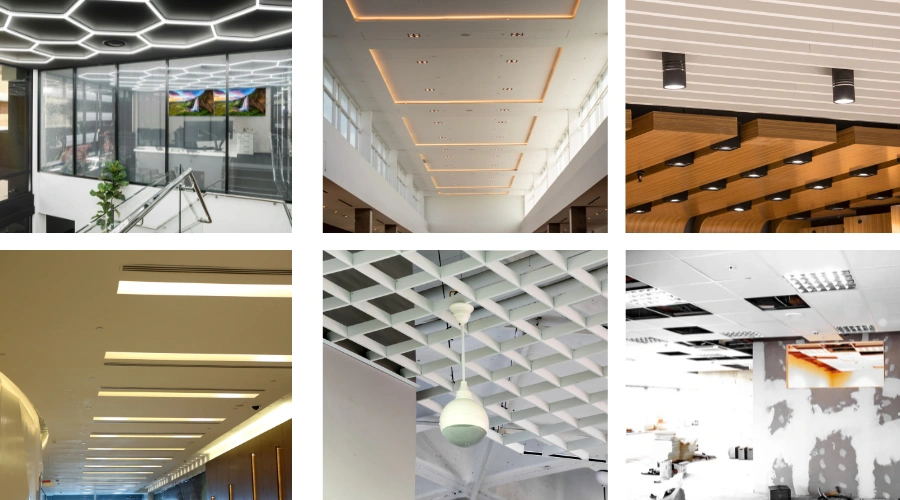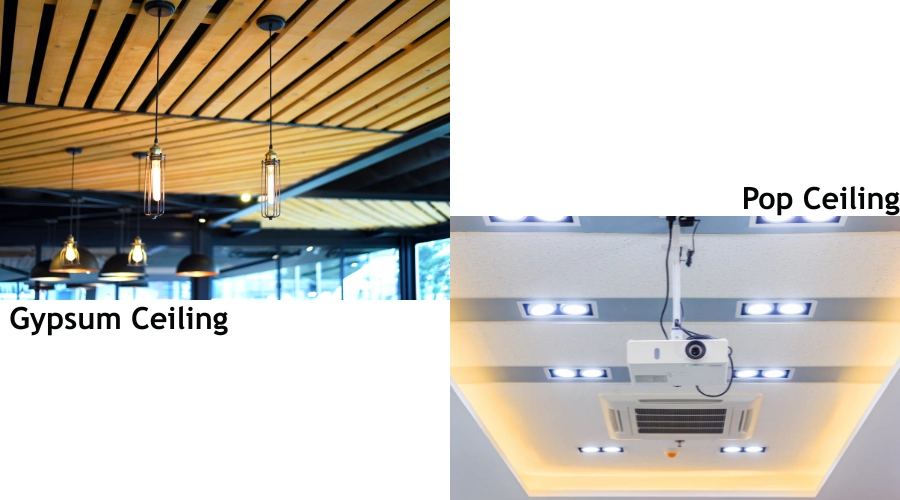False ceilings are an essential part of modern homes, as they are likely to enhance the beauty of a place and add style and personality. People used ceilings that were typically made of simple designs in homes until the development of false ceilings. Installing false ceilings may give benefits like hiding electrical wiring and ducts, reducing noise, and helping to keep your home cool for all time. When compared to plaster of Paris, ceilings made of gypsum will provide additional benefits for homeowners in terms of cost and effectiveness.
In this Brick & Bolt article, we’ll take you through gypsum ceilings, how they are installed, and why they will be a great addition to your home.
What is a Gypsum False Ceiling?
Gypsum false ceilings are very durable, long-lasting, and economical in residential and commercial spaces. The boards used here are made from gypsum plasterboards. They fix them onto a metal frame by screwing, so the manufacturing process of boards in the factory ensures dustless installation. Besides this, gypsum ceilings don’t absorb much moisture. The fire-resistant core of gypsum ceilings gives them a safe feature for commercial and residential usage and still accommodates a wide range of modern interior designs.
Colours and Types of Gypsum False Ceilings

Gypsum occurs naturally in white, grey, red, brown, and yellow colours. Gypsum boards come in many varieties, namely regular, fire-resistant, moisture-resistant, exterior soffit boards, and impact-resistant types. The great thing is that gypsum ceilings have different finishes to choose from such as laminate, wallpaper, and textured designs.
Latest Design Trends of Gypsum False Ceilings
Soft Lighting: Cove, diffused, and statement lights generally make gypsum ceilings look more elegant.
Geometric Designs: Abstract patterns, coffered layers, and circular styles add depth and style.
Wooden Rafters: Wood combined with gypsum ceilings gives a warm, sophisticated look.
Mirrored Ceilings: Combining gypsum and mirrors gives an opulent appearance.
Smart Lighting: LED strips, recessed lights, and chandeliers upgrade aesthetics and functionality.
Installation Process
Professionals can install a gypsum ceiling effectively to ensure safety and a perfect finish. Here’s a simple breakdown:
Marking the Wall
Make sure the location of the cladding wall is safe before proceeding. Mark the location with a pencil, then align it with the ceiling using a plumb.
Measuring and Cutting Metal Profiles
Determine the height of the wall and select U and C profiles. For easier fitting, cut the C profiles about 1 cm shorter than the ceiling height.
Resolving U Profiles
Use screws, dowels, and drill-driven washers to fasten the U profiles to the ceiling and floor.
Setting Up Staples
Measure the distance between the wall and the cladding to select the appropriate staples.
Insulation and Wiring
Install an access panel for plumbing and electrical if necessary. Before repairing the panels, finish all of the wiring.
Plasterboard Attachment
For stability, provide a 30-cm space between the gypsum board and the U and C profiles after attaching the board with screws.
Final Touches
After applying several coats of jointing compound, give it a full day to set. After it’s dry, embellish the ceiling to your satisfaction.
Why Choose Gypsum False Ceiling?
Gypsum false ceilings have a perfect blend of aesthetics, functionality, and safety. It enhances the beauty of any space, reduces noise, and keeps the rooms cool. Whether it is about homes, offices, or other commercial buildings, it is a clever solution with a fashionable appearance. Easy installation and durability are also beneficial.
They increase the value of your interior while offering insulation and fire resistance. When renovating, one should opt for a gypsum ceiling to deliver a contemporary and sophisticated finish.
Gypsum Ceiling Illumination Tips
Choosing the right lighting enhances gypsum ceilings beautifully. LED and cove lighting create ambience, while statement lights may need extra LED support for full illumination. Soft lighting suits bedrooms in which dimmers adjust brightness. Pendant lights add style to kitchens and dining areas.
Lighting Options:
- Strip lighting: Affordable and stylish.
- Recessed lighting: Highlights walls.
- Backlights: Adds a glowing effect.
- Diffused lighting: Soft and cosy.
- Pendant lights & chandeliers: Elegant and eye-catching.
Things You Should Know Before Putting a Gypsum Ceiling
Things to keep in mind for gypsum ceilings:
- Budget-Friendly Choice – If you’re on a tight budget, limit the use of gypsum. A simple border design with carvings can still look stylish.
- Ceiling Height – For low ceilings, a gypsum border design helps maintain the height without making the space feel smaller.
- Cost-Effective – Gypsum is an affordable and widely recommended material compared to others.
- Weight Considerations – Gypsum ceilings can be heavy. Before adding layers or chandeliers, ensure the structure can support them.
- Fan & Swings – Attach the fan and any swing hooks to the main ceiling before installing gypsum.
Comparison of Gypsum Ceiling and Pop Ceiling

The simple comparison table will help you to understand the uniqueness of gypsum ceilings for your homes.
| Feature | Gypsum Ceilings | POP Ceilings |
| Installation | Ready-made and easy-to-install | Takes time and can be messy. |
| Durability | Strong and seamless | Long-lasting but prone to cracks |
| Fire & Water Resistance | Fire-resistant and moisture-resistant | Fire-resistant but not water-resistant |
| Cost | More expensive and gives a sleek look | Less expensive, but may develop cracks. |
| Customisation | Limited designs, factory-made | Highly customisable for unique designs |
Advantages of Gypsum Ceilings
Several add-on benefits of gypsum ceilings are as follows:
- Budget-Friendly & Stylish – Gypsum boards are soft and flexible, allowing beautiful ceiling designs without high costs.
- Keeps Your Home Cool – Gypsum False ceilings help block heat, keeping rooms cooler for longer.
- Fire Resistant – The tightly packed layers can resist fire for up to 4 hours, adding safety.
- Reduces Noise – Its acoustic properties help block sound, ensuring a quieter space.
- Quick & Clean Installation – Gypsum boards are pre-made, require no water, create less dust, and set within a day, unlike other materials that take a week or more.
Disadvantages of Gypsum Ceilings
Even though we celebrate the invention of the gypsum ceiling, it also has some drawbacks for its users as follows:
- Gypsum ceilings usually can’t be repaired if damaged.
- Standard gypsum boards don’t handle moisture well unless you choose a water-resistant type.
- Regular gypsum ceilings can develop cracks easily, so it’s important to choose high-quality ones from a trusted brand.
Maintenance Tips
Easy tips to maintain your gypsum ceiling are as follows:
- Dust regularly, as dust and dirt settle overtime on a ceiling. Dust it using a soft cloth or vacuum cleaner.
- Keep it dry. Though many gypsum boards have moisture resistance, too much water can damage them. Wipe the spills right away.
- Paint when needed. Freshen the look by repainting the ceiling whenever it begins to fade. Make sure that it retains a smooth finish using the right primer and paint.
With all these above-said simple steps, you can maintain a clean, fresh, and long-lasting gypsum ceiling.
Conclusion
A gypsum false ceiling is a fashionable, durable, and practical choice for modern interiors. It adds to the aesthetics, provides insulation, and can be used for creative lighting designs. Though it needs professional installation and care, its smooth finish and versatility make it a popular choice for homes and offices. Whether you want a minimalist look or an intricate design, gypsum ceilings add value and class to the space. These will be worthy long-term investments for beauty and functionality.

